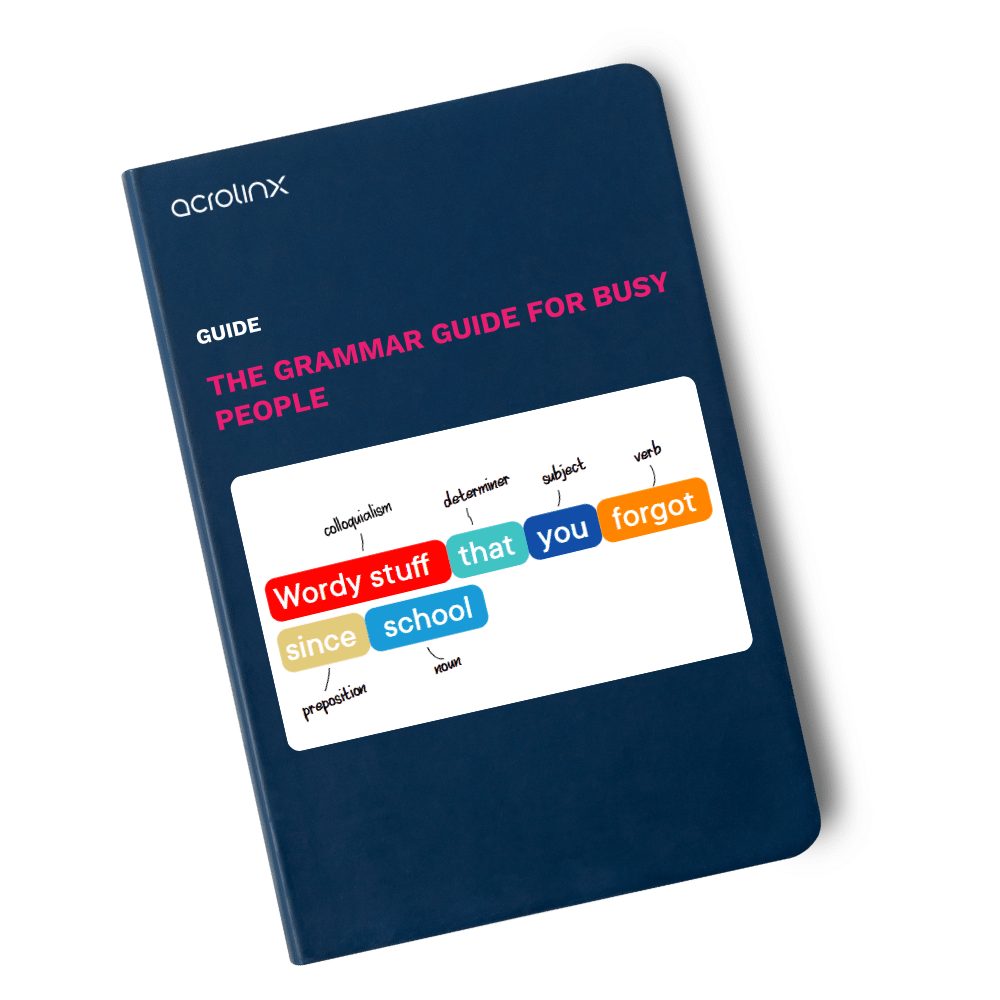
If you’ve ever questioned, how do English style guides differ from grammar guides and usage handbooks — this is the blog for you! But first, a little quiz to check your prior knowledge. Let’s get started!
Quiz yourself
What’s the difference between style manuals and grammar guides?
- They’re basically the same thing, just with different names.
- Style guides help with consistency but not Spelling and Grammar.
- Grammar guides are a school thing, style guides are a brand tool.
- Style guides are specific to academic writing.
If you’re not sure which answer is correct, read on. We’re certain by the end of this post, you’ll be able to work it out. And if not, we’ll reveal the answer along the way.
What’s a style guide?
A style guide (also known as a style manual) is a set of standards for writing and structuring documents. The goal of a style guide is to give content, usually for a specific audience, purpose, or industry, a uniform style and format. Some style guides also cover elements such as typography and white space, while others will include the use of visual elements along with text. Some of the most common style guides you may be familiar with include:
Most major brands will also have their own style guide, often inspired by the above style manuals. A corporate content style guide is the backbone of your enterprise content strategy. In a perfect world, it unites all your content contributors — no matter where they work. It helps them standardize their writing style and tone, including the correct use of the Terminology unique to your business. It also keeps them on message and speaking in your brand voice.
What is a grammar guide?
Grammar is different to style, in that there’s definitive right and wrong ways to construct a sentence. Grammar mistakes confuse your audience and dilute your message. And in the case of the Oxford comma, can even have legal ramifications! But on the other hand, style can be a matter of preference (although still grammatically correct) and is more dependent on your audience and where you’ll publish the content.
A grammar guide will usually focus on how to accurately structure and write a sentence, making sure you’re meeting accepted writing conventions that many of us take for granted. While you’ll likely find grammar guidelines in style guides, you’ll be less likely to find style guidelines in grammar guides.
Back to the first question at the beginning of this blog. To an extent, style guides help with consistency more than they do with spelling and grammar. Grammar guides are the best source to consult if you’re unsure about syntax and perplexing punctuation, but your company style guide will tell you if your company voice uses US or UK spelling and if you should use an Oxford comma.
Challenges in global companies’ content
The European Union (EU) statistics on self-reported foreign language skills show that 24.8% of working-age adults in the EU can speak at least one foreign language at a proficient level, with 80% reporting they know a second language. While the benefits of working in a second, third, or fourth language are huge, there remains the challenge to keep content clear, consistent, and grammatically correct in the chosen business language.
In-house style guides and grammar guides are one way that global companies try to introduce a consistent style, tone, and terminology across all branded content. But the issue with PDFs or static grammar guides are that they:
- Assume everyone has the same background of grammar education in their first language.
- Show only the correct version without any explanation of why it’s preferred.
- Miss contextual information and clearly explained exceptions to the rule.
- Can’t be easily reviewed or updated as language evolves.
- Make it difficult to track who’s using it while they write.
Relying on content creators to consult grammar guides out of their own volition can lead to pesky errors in your content that take time (and money!) to edit out. As a result, easy-to-avoid mistakes slow your enterprise content operation. There’s nothing more frustrating than subject matter experts getting bogged down in dangling modifiers, instead of focusing on higher value edits that help create a better customer experience.
But guess what? Grammar is relevant for everyone, including native English speakers that apply grammar rules somewhat intuitively. Many content creators today are creating content secondary to their main role, and wouldn’t consider themselves professional writers. If that’s you, you might be interested in our eBook: The Grammar Guide for Busy People: Wordy Stuff You Forgot Since School. It contains a bunch of quick and dirty tips to get you writing like an English professor in no time!
Addressing global content challenges with practical solutions
Creating content across global teams can be tough, with different languages and cultural nuances adding complexity. Let’s explore some easy solutions to overcome common content challenges and keep your messaging consistent.
1. Standardizing language across regions
Language differences like American vs. British English can create confusion.
To standardize your language across regions, create a global style guide to specify language preferences, regional terms, and spelling. This keeps your content consistent, no matter where it’s read.
2. Consistent tone of voice
What works in one region might not in another. Include tone of voice guidelines in your global style guide to adapt content to local audiences while keeping your brand consistent.
3. Visual examples for clarity
Written guidelines are helpful, but visuals ensure understanding. Add visual examples to your style guide, showing correct and incorrect content formats to avoid misinterpretation.
4. Easy access and regular updates
Static PDFs can quickly become outdated. Switch to an online style guide that’s always up to date and easy to access for remote teams. Content governance software like Acrolinx digitizes your style guide and guides writers right in the applications they use.
5. AI Tools to streamline content creation
Managing content across languages can be time-consuming. Use AI-powered tools like Acrolinx to automate content checks, ensuring consistency and saving time.
Acrolinx: Digital grammar guides for every team
Acrolinx is an AI-powered content governance software that increases the quality and effectiveness of enterprise content. It rolls your company style guide and grammar guides into one, so you have tailored guidance for every content type, for every target audience.
At Acrolinx, we know that grammar is the foundation of good content. But our mission is to help power a world with amazing content. And amazing content is way more than just grammatically correct.
Amazing content has the following characteristics:
- Inclusive
- Scannable
- Relevant
- Consistent
- Clear
- Accessible
- Accurate
- Emotionally appealing
Amazing content connects content goals to measurable business outcomes. For example, are you getting the conversions you’re looking for? If not, perhaps the clarity of your content needs adjusting — by creating a guideline for shorter sentences for snappier email copy.
And the best thing? You can create, update, customize, and evolve your content strategy and guidelines with a few clicks, and complete transparency into how content is performing. What kind of content goals belong in the grammar guides of today? Let’s find out.
Content goals for better content
Here’s a list of goals that Acrolinx can check for, and how they improve your content:
Goal Description Correctness Correctness helps content creators write with proper spelling and grammar, with helpful recommendations for writing in their non-native language. Writing error-free content from the first draft shortens the editorial process and prevents embarrassing inconsistencies in the names of products, new features, or even your company messaging. Clarity Your content likely speaks to different stakeholders in the customer journey. Some of them will prefer more technical explanations, and others not so much. Make sure your content is clear and easy to understand, and improve the quality of your translations with clearer source content. Consistency By choosing this goal, you’re selecting Guidelines that help your teams write in a consistent style.For example, inconsistent use of the Oxford comma can lead to compliance issues. Or if you’re using acronyms, Acrolinx will recognize if you’ve used them before defining what they stand for. Tone Different audiences prefer a different tone of voice. Acrolinx can help you adjust the tone of your written content to either formal or informal. This is perfect for those brands who speak to a broad target audience or have both B2B and B2C communication needs. Scannability Scannability helps you structure your content to make it more visually appealing. But it’s not just about aesthetics. Scannable content improves information retention, which increases the chances that customers will find the answers they’re looking for, improve their ability to self-serve, and have higher satisfaction. Inclusive Language The Guidelines under this goal help you use language that’s welcoming to diverse audiences, and avoid potentially discriminatory language.
Beyond grammar guides: Introducing content fitness
Using technology to improve your content’s fitness results in higher-performing content that resonates with your audience. When you consider that each stage in the customer journey relies on content touchpoints, there are endless opportunities to connect with your audience through content. So it’s time to start maximizing the value of those touchpoints with fit content.
Ready to get started? First, brush up on some grammar in the Grammar Guide for Busy People, and then learn about content fitness and why we’ve moved on from talking about “content quality.”
Frequently asked questions
APA, Chicago Manual of Style, and AP Stylebook. Acrolinx digitizes your custom style guide to govern enterprise content directly in authoring tools.
Style guides define brand voice and formatting preferences; grammar guides focus on language rules. Acrolinx enforces both within enterprise content.
APA style governs structure, citations, tone, and formatting in academic writing. Acrolinx supports enforcing APA-aligned guidelines if required.
APA, MLA, and Chicago Manual of Style. Acrolinx supports alignment with any guide — including your custom enterprise standards.
Are you ready to create more content faster?
Schedule a demo to see how content governance and AI guardrails will drastically improve content quality, compliance, and efficiency.

Kiana Minkie
She comes to her content career from a science background and a love of storytelling. Committed to the power of intentional communication to create social change, Kiana has published a plethora of B2B content on the importance of inclusive language in the workplace. Kiana, along with the Acrolinx Marketing Team, won a Silver Stevie Award at the 18th Annual International Business Awards® for Marketing Department of the Year. She also started the Acrolinx Diversity and Inclusion committee, and is a driving force behind employee-driven inclusion efforts.





